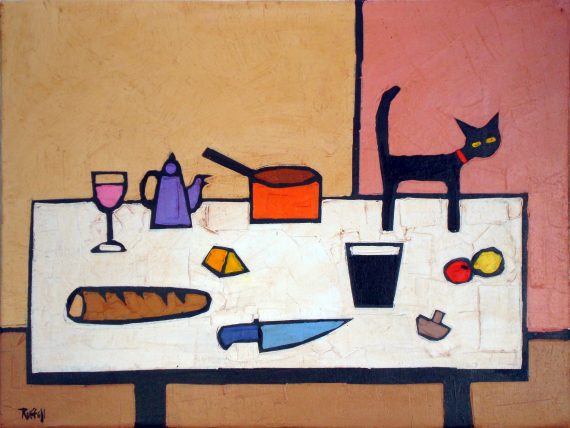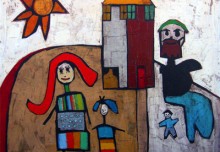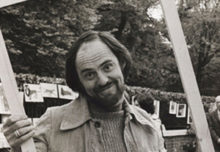Cloisonism! Huh?
Most people haven’t heard of cloisonism.
But just about everybody has seen it.
They just didn’t know that it was called cloisonism.
So what is it?
It is that kind of drawing and painting where the objects are outlined in black lines.
And the areas between are coloured in blocks of colour.
Like some comics and cartoons.
Or like this in this painting of mine with a black cat. One of my black cat series.

Casa Ava Table Top by Colin Ruffell OAE100191
The first use of the term seems to be just after the French Impressionist period, part of the Post-Impressionist period. The most often quoted exponents are Emile Bernard, Paul Gaugin, and even Van Gogh.
Wikepedia
The term was coined by critic Edouard Dujardinon the occasion of the Salon des Indépendants, in March 1888.[
The name evokes the technique of cloisonné, where wires (cloisons or “compartments”) are soldered to the body of the piece, filled with powdered glass, and then fired.
New York Times
Just under a hundred years later a New York Times cutting quotes “…..the term refers to thin metal strips or wires attached to a flat metal surface to form self-contained compartments. These strictly divided compartments served as containers of pure color. What resulted was a style – at once antinaturalistic and quasi-abstract in spirit – similar to that found in the art of stained-glass windows and Japanese prints.” From a travelling exhibition [Toronto then Amsterdam] called ‘ Van Gogh and the Birth of Cloisonism’, curated by Prof. Bogomola Welsh of the University of Toronto.
So, to make it clear, an artist painting in the cloisonist style doesn’t use thin wire between areas of colour, and the artist doesn’t have to fire the painting in a kiln. It just looks like it sometimes.
Another reaction that I encounter quite often is that this style of painting looks like children’s art. I actually take that as a compliment.
So what is special about the technique? Why is it controversial?
If Van Gogh and Paul Gaugin did it then it can’t be bad.
But if kids can do it and it is used in comics then it can’t be any good.
Maybe it is all to do with drawing. Or maybe it is all about the way human eyes work. Or is it to do with printing processes. And what about all these long words.
Drawing.
When an artist does a drawing they will usually use a pencil or other tool that makes lines. If you draw using lines it is common sense that you would draw the edges of things using lines. Even though they are not there. [There are not lines round or along the edges of things. Just edges.]
Eyes.
The way our mind interprets the signal that comes from our eyes is complex. Sub-consciously the brain accepts a mass of input data from the retina and makes sense of it by looking for contrast and pattern. A series of linked contrasts gives the brain a clue that this is an edge. It even seeks out more contrast and exaggerates it to make sense. Bingo. Your brain draws edges in lines.
Cartoons and comics.
The use of black outlines with flat coloured areas is a result of speed and simplicity in creation and publishing. The reader wants to get the message quickly and simply. Subtlety of shaded drawing and graduating tones would be much harder to get right. A cloisonistic style of drawing and colouring can be effectively and economically printed for a comic book, magazine, or newspaper using very basic four colour printing presses.
Antinaturalistic and quasi-abstract cloisonism.
The New York Times quote above used these terms to describe something that seems so simple. I wonder if kids realise that they are using antinaturalistic and quasi-abstract drawing techniques when they draw. Probably not. Kids drawings are often about the subject and not about what it looks like. Perspective is not involved because that is all about appearance. That’s the antinaturalistic bit.
Quasi-abstract is yet another tricky concept. Quasi means pseudo or mock. So mock abstract? Abstraction usually means the same as non-subjective. Meaning that it is not about anything else but just about itself. For instance pattern and internal relationships. So quasi abstraction is pretending that it is not about something even though it is. Hey ho!
Personally I just liked the impressionist way of painting, then I liked the post-impressionist stuff including ‘cloisonism’ even though I didn’t know that it was called that. How about you?




